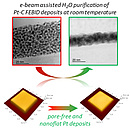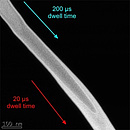Focused Electron BEAM Induced Processing (FEBIP)
Focused Electron Beam Induced Deposition (FEBID) is a versatile method for the fabrication of functional nanostructures. The technique uses gaseous precursor molecules brought into the microscope chamber which then are locally dissociated by electron-molecule interactions. Full control of the electron beam by means of position and pulse duration do not only allow fabrication of nanoscale structures but also for free-standing 3D architectures as a unique capability.
Emphasis of our scientific activities are 1) relation between processing strategies and structure / chemistry / functionality, 2) morphology control towards highest spatial resolution including free-standing 3D fabrication; and 3) development of new application concepts mainly based on the nanogranular metal-matrix composition of FEBID related materials.
Emphasis of our scientific activities are 1) relation between processing strategies and structure / chemistry / functionality, 2) morphology control towards highest spatial resolution including free-standing 3D fabrication; and 3) development of new application concepts mainly based on the nanogranular metal-matrix composition of FEBID related materials.
Highlights
 ©FELMI-ZFE | E-beam Assisted H2O Purification At Room Temperature: As FEBID structures mostly suffer from severe carbon incorporation up to 90 at.% we have introduced a fast and simple purification approach allowing entire carbon removal while surface shapes and lateral footprint are fully maintained without any porosity. “Rapid and highly compact purification for focused electron beam induced deposits: a low temperature approach using electron stimulated H2O reactions” by Geier et-al, ACS J. Phys. Chem. C (2014), in review |
 ©FELMI-ZFE | Intrinsic Resolution Limitations: We have studied the fundamental resolution limitations during FEBID on bulk substrates and could show that the deposit itself is stgrongly determining finally achievable lateral resolution. “Fundamental resolution limitations during electron induced direct write synthesis ” by Arnold et-al, ACS Appl. Mat. & Interf. (2014), doi: 10.1021/am5008003 |
 ©FELMI-ZFE | Spatial chemistry evolution during FEBID: In this study we link the local precursor working regime with evolving chemistries / functionalities and demonstrate massive chemistry gradients within the first 100 nm deposit growth. ”Spatial chemistry evolution during focused electron beam induced deposition: origins and workarounds” by Winkler et-al, Appl. Phys. A (2014), doi: 10.1007/s00339-014-8496-y |
 ©FELMI-ZFE | Directional gas flux effects: the study elaborates morphological effects during FEBID originating from directional gas fluxes. In particular, the high relevance of pattern alignment and strategies is emphasised towards ideally shaped deposits. “The Nanoscale Implications of a Molecular Gas Beam during Electron Beam Induced Deposition” by Winkler et-al, ACS Appl. Mat. & Interf. (2014), 6 (4), 2987 |
 ©FELMI-ZFE | FEBID based Pt-C gas sensor: We have demonstrated a new application concept using the nanogranular Pt-C metal-matrix structure for gas sensing applications. In particular the effect is based on variable tunneling barriers of in the presence of polar gas molecules on the sensor surface. “Variable tunneling barriers in FEBID based PtC metal-matrix nanocomposits as transducing element for humidity sensing” by Kolb et-al, Nanotechnology (2013), 24, 305501 |
 ©FELMI-ZFE | Chemical variations during FEBID: The relation between process parameter, precursor working regime and final chemistries has been studied revealing two different types of incorporated carbon by means of incompletely dissociated precursor molecules and polymerized carbon. “Chemical tuning of PtC nanostructures fabricated via focused electron beam induced deposition” by Plank et-al, Nanotechnology (2013), 24, 1753052013 |
 ©FELMI-ZFE | Functional tuning of FEBID based Pt-C deposits: Post-growth e-beam curing is demonstrated to improve electric conductivity up to three orders of magnitude in dependence on the precursor working regime used during fabrication. “Optimization of postgrowth electron-beam curing for focused electron-beam-induced Pt deposits” by Plank et-al, J. Vac. Sci. Tech. B (2011), 29, 051801 |
Contact
Institute of Electron Microscopy
and Nanoanalysis
Steyrergasse 17/III
8010 Graz
General Information
Verica Bursac
Phone: +43 (0) 316 873 8320
Fax: +43 (0) 316 373 8822
office@felmi-zfe.at
Service Related Inquiries
Hartmuth Schröttner
Phone: +43 (0) 316 873 8349
hartmuth.schroettner@felmi-zfe.at